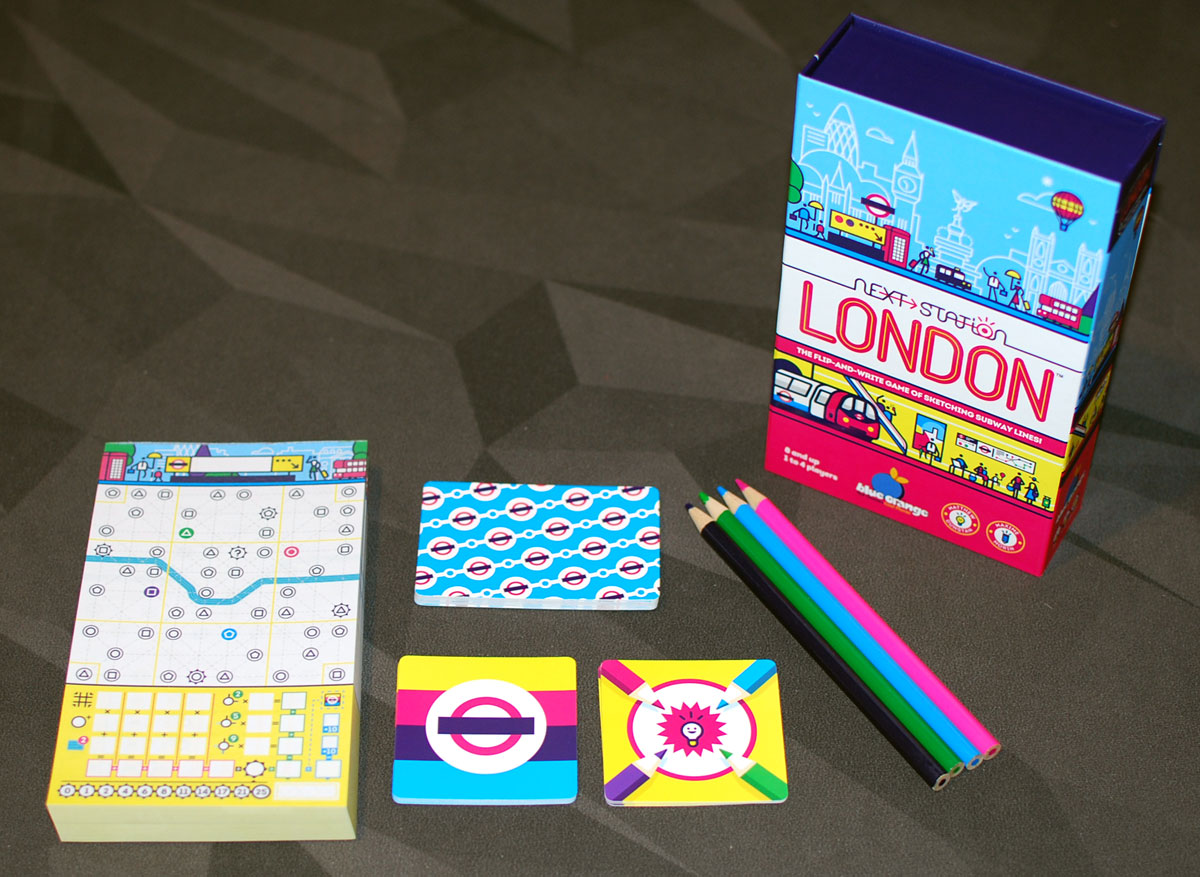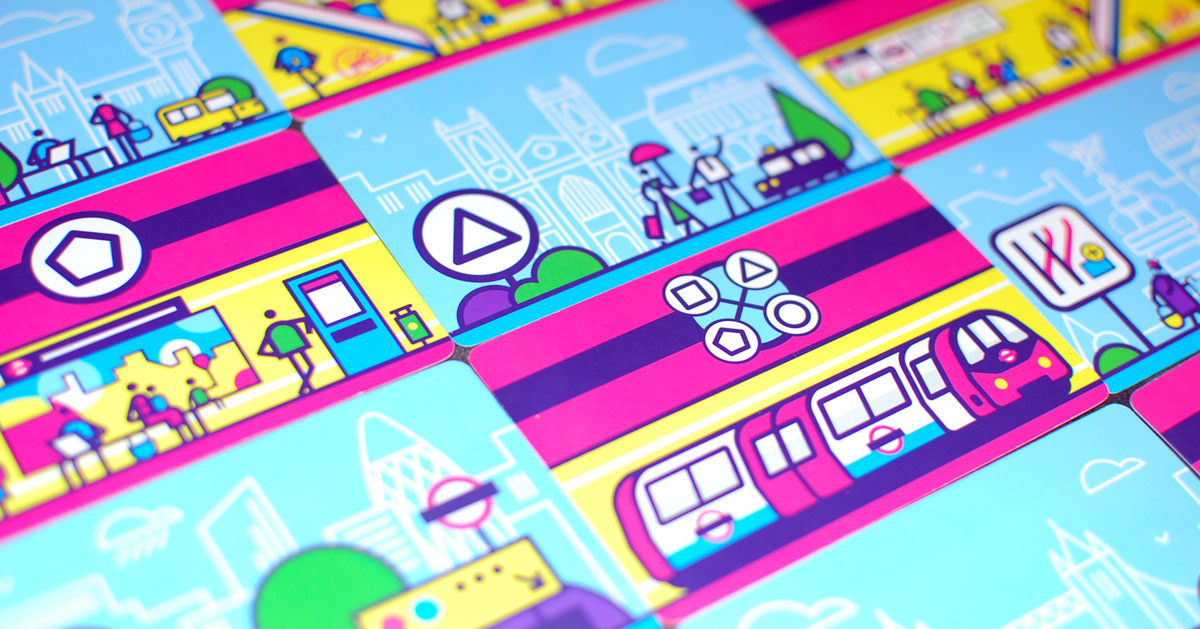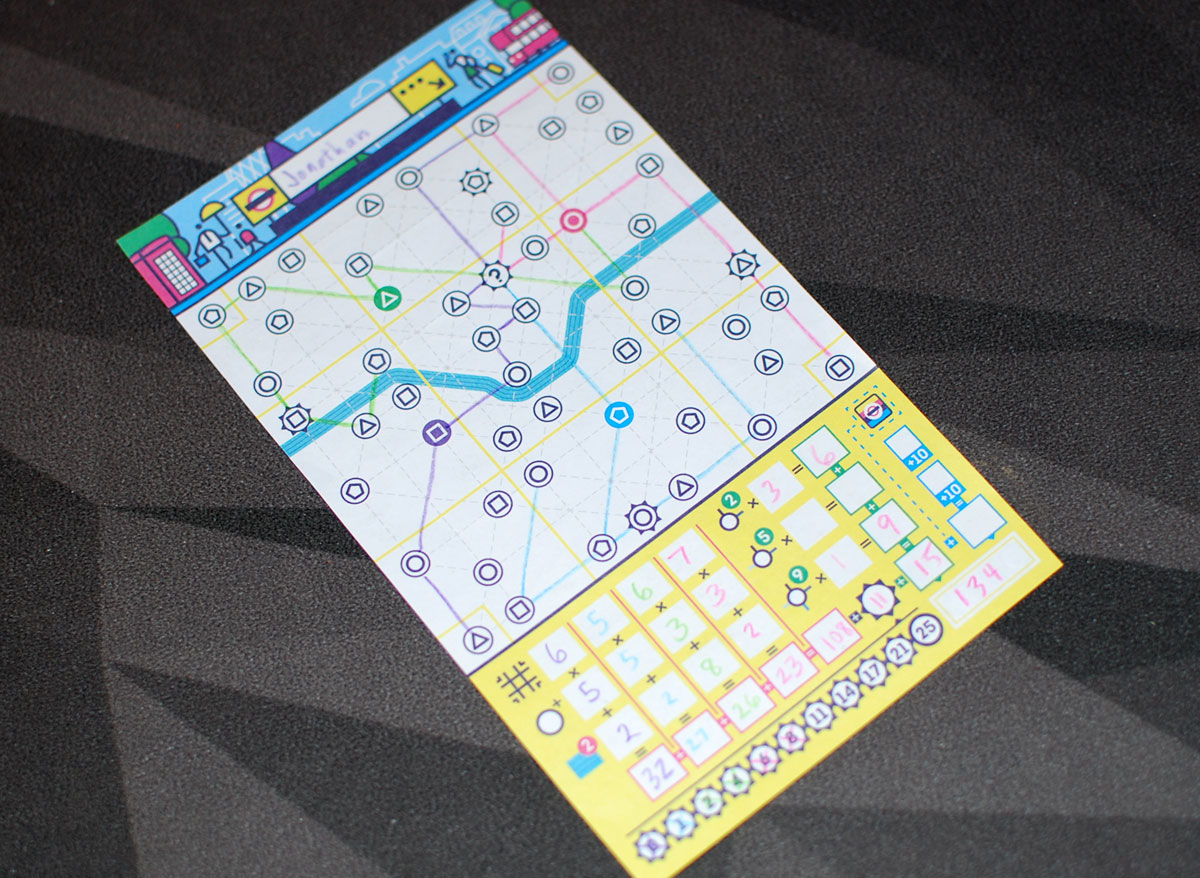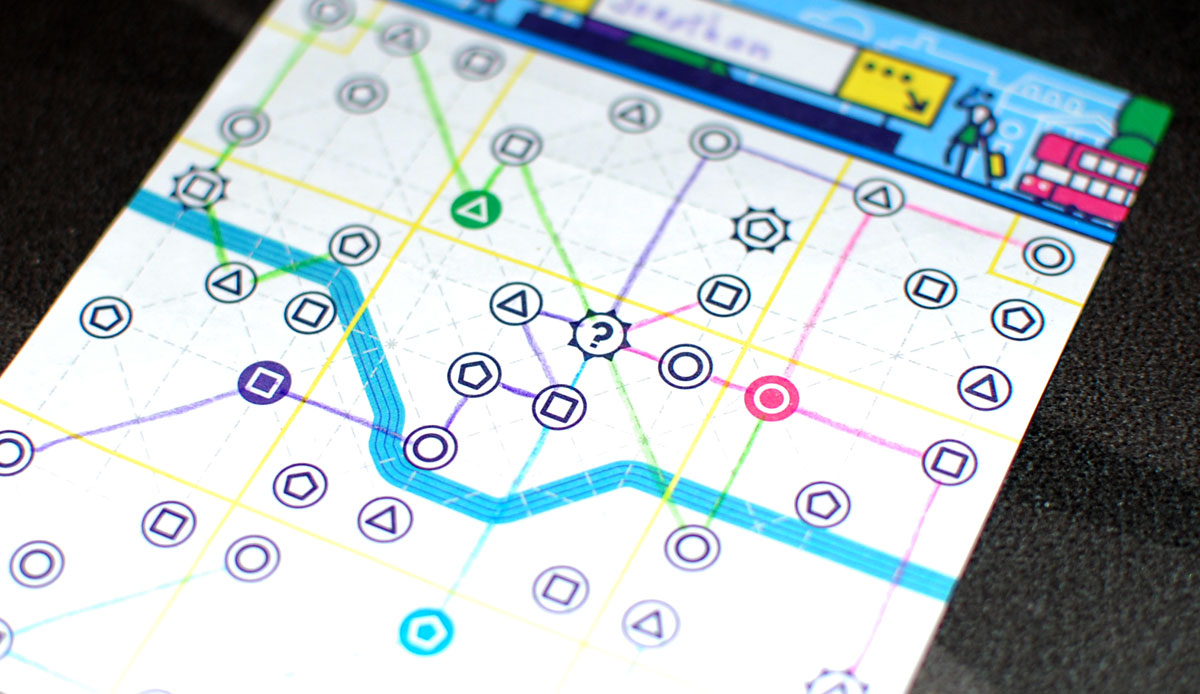You’ve been hired to redesign the London Underground! Can you build the most efficient routes?
What Is Next Station: London?
Next Station: London is a flip-and-fill, map-making game for 1 to 4 players, ages 8 and up, and takes about 25 minutes to play. It retails for $17.99 and is available in stores now or directly from Blue Orange Games. It is family-friendly, with ways to add or remove complexity depending on the players.
Next Station: London was designed by Matthew Dunstan and published by Blue Orange Games, with illustrations by Maxime Morin.

Next Station: London Components
Here’s what comes in the box:
- 200 London Map sheets
- 20 Cards:
- 11 Station cards
- 5 Shared Objective cards
- 4 Pencil Power cards
- 4 Colored pencils
The scorepad shows a simplified map of London with various spots on a grid, marked by different shapes. At the top there’s a little illustration along with an Underground sign so you can write your name, and below the map is a section used for scoring. The sheets are double-sided so you can use each one twice before recycling it.

The station cards come in two colors, blue and pink, representing the street-level stations and the underground stations. These also have fun little illustrations showing commuters at the various stops, along with some London landmarks in the background of the street-level cards. The objective cards and pencil power cards are small square cards and each shows a simple icon—you’ll need to refer to the rules the first few times you play, but then they’re fairly intuitive.
The four colored pencils are green, pink, purple, and blue—you could perhaps play with more people at once if you had more pencils. The one thing that would be nice (as with most games that use pencils) is if it included a small pencil sharpener.
The whole thing fits into a small box with a magnetic flap lid, similar to the box for Downtown Farmers Market. It’s a nice size for portability. In this case, the box starts off full but as you use up the scoresheets there will be a little more space inside for things to rattle around.

How to Play Next Station: London
You can download a copy of the rulesheet here. (Note that the formatting will look a little strange on-screen, because it’s printed as a long sheet, accordion-folded.)
The Goal
The goal of the game is to score the most points across 4 Underground lines.
Setup
Give each player a scoresheet and a pencil. Note that you will always use all 4 pencils in each game, regardless of the player count, because each player will use each color once. Shuffle the station cards and place them in a face-down pile. The objectives and pencil powers are for the advanced play, so I’ll skip those for now.

Gameplay
Each turn, the top station card is flipped over, and everyone may then draw a line. When you begin the round, you need to find the station that matches your pencil color—that’s your starting station. After that, you may extend your line from either end (but not somewhere in the middle).
You must draw your line along one of the existing dotted lines, and you connect directly to a station that matches the card just drawn, without passing over any other stations or any previously drawn lines, regardless of color. (Underground lines may only intersect at the stations themselves.) If you cannot reach a matching station from either end of your line, then you skip drawing that turn; you may also choose to skip drawing a line if you don’t like where it would go. You may also not draw a line on a path where there is already an existing line.

The starburst stations are special: the one marked with a question mark is Central Station, and is a wild shape—you can connect to it regardless of the symbol shown on the station card. The rest are tourist sites. Any time you connect to a starburst station, you mark off a starburst icon at the bottom of the score sheet.

The railroad switch card (a blue station card) allows you to branch off from anywhere along your current line. When this card is flipped, immediately flip a second card to show what shape to connect to. (If the switch is revealed in the first two turns, there’s no place to branch from so it has no special effect.) There are also wild cards that allow you to draw to any shape.
The round ends after the 5th pink card is flipped. Players draw that last line, and then the round ends.
Here’s how you score for the round, recorded on the bottom section of the sheet.
Count the number of different districts your line passed through. There are 13 districts total: each corner station is its own district, and then there are 9 more in a tic-tac-toe pattern. Then, find the district where your line passed through the most stations and count the number of stations it touched there. Multiply these two numbers, and then add 2 points for each time your line crossed the River Thames. That’s your score for this line.
At the end of the round, everyone passes their pencils clockwise. (If you have fewer than 4 players, there should be some pencils between players that get passed along.) Reshuffle all of the station cards and start a new round.

Game End
The game ends after four rounds, when everyone has built an Underground line in each of the four colors.
Calculate your final score:
- Add up the points for the 4 lines.
- Look at the lowest tourist site starburst you have not crossed off, and score that number.
- Count your interchanges, the stations with more than one color touching them.
- Each interchange with 2 colors: 2 points
- Each interchange with 3 colors: 5 points
- Each interchange with 4 colors: 9 points
The highest score wins, with ties going to the player with the single highest Underground line score.

Shared Objectives
To use the objective cards, shuffle and deal 2 face-up at the start of the game. Each of these is worth 10 points if you achieve the objective by the end of the game using a combination of your four Underground lines.
The objectives are:
- Make at least 8 interchanges.
- Pass through all 13 districts.
- Reach all 5 tourist sites.
- Touch all 9 stations in the center district.
- Cross the Thames at least 6 times.

Pencil Powers
To use the Pencil Powers cards, shuffle and deal 1 card to go with each pencil, and then reveal them. As you pass the pencils, you also pass the power card. Each power can be used once per player.
The powers are:
- Use the current station card twice.
- Treat the current station card as a wild.
- Play as if a route switch card had been played with the current station card.
- Circle one of the stations on your route—it counts as 2 stations (for this Underground line only).
Solo Mode
The solo mode is essentially the same; you cycle through all four pencil colors (and all four pencil powers, if you’re using those). You subtract 10 points for each of the advanced modules (shared objectives and pencil powers) that you played with, and then compare your final score to the chart, which has tiers ranging from “<90 points” to “>150 points.”
Next Station: London is GeekDad Approved!
Why You Should Play Next Station: London
Maybe part of what makes Next Station: London such a cozy game to play is that it feels a little bit like filling out a dot-to-dot page, except with a little bit of mystery about where the next dot will go. It also scratches that route-building itch, the one that makes train games so popular, because it’s fun to make those connections and plot out a route, trying to get from one place to another. It reminds me a little of Metro X, though that one felt a little more restricting because you were filling out preexisting lines and hoping for the right numbers to come up; this one is a bit more like a sandbox where you can go in several different directions.
The game does have a little bit of a solitaire feel, in that you can’t affect another player at all—each player is filling out their sheet independently, and your domain is your own. That’s not unusual in the roll-and-write, flip-and-fill genre: quite often, players fill out their own sheets based on a common roll or draw. However, one twist that Next Station: London has is that you’re each filling out a different color, which means you won’t end up with the same map, and you can’t copy each other. If the card flipped over is a circle, we each need to draw a path to a circle—but I’m starting at the green triangle station, and you’re starting at the blue pentagon. By the time I’m working on my blue line, the order of the stations will be different, and I’ll end up with different possibilities than the ones you had.
Next Station: London gives you some tough choices to make: since the score for your line is the number of districts multiplied by a number of stations within a district, you need a bit of both. If you zip across the map and cover 9 districts but only hit one station in each one, that’s only 9 points. If you only cover 4 districts but hit 4 stations in one of them, that’s 16 points! Going too far in the other direction, hitting lots of stations in a small area, will punish you the other way.
You also have to beware of boxing yourself in. One of the first times I played, I was eager to reach the tourist sites and ran my blue line halfway across the map simply because of the particular order that the station cards were drawn. It was only halfway through the game that I realized I’d made it almost impossible to get to the southeast corner of my map with any of the other colors. While you can intersect at stations (and interchanges are valuable!), you have to be careful to allow yourself room to maneuver.
The objectives give you some long-term goals to work on beyond just maximizing your current line. If you’re trying to reach all 13 districts, you may find it harder to have high values for the “stations in a district” part of your score. If you’re zigzagging across the river, you might not make it to as many tourist sites. There are some balances you’ll need to strike.
The pencil powers are also a fun way to mix things up. Everyone will get the same powers tied to the same colors during a game—for instance, the pink pencil might be the one that gets a free track split. But the next time you play, you’ll have a different combination, and now the blue pencil gets a track split. Figuring out when to use your power each round can be tough—use it too soon, and you may regret it when a better opportunity comes up later. But wait too long, and the round could be over!
The uncertainty of when the round will end also makes for some nice tension. In the station cards, there’s one of each shape in blue and pink, one wild in each color, and then the blue track split card. A round could be anywhere between 5 and 11 cards, and I’ve experienced both. You can also tell from the cards that are out which possibilities are left in the deck. There are times when I’ve used a wild as a particular shape, only to realize that none of that shape had been drawn yet and I might get it two more times in the round. Are both circles already on the table? Well, then you’ll need to hope for a wild if you want to reach that circle tourist site—don’t forget!
I’ve really enjoyed playing Next Station: London, and I’m giving it the GeekDad seal of approval. I think it’s an excellent game that’s a bit of a puzzle, and one that the whole family can enjoy.
For more information, visit the Blue Orange Games website.
Click here to see all our tabletop game reviews.
![]() To subscribe to GeekDad’s tabletop gaming coverage, please copy this link and add it to your RSS reader.
To subscribe to GeekDad’s tabletop gaming coverage, please copy this link and add it to your RSS reader.
Disclosure: GeekDad received a copy of this game for review purposes.





